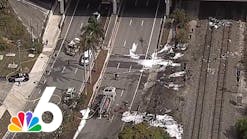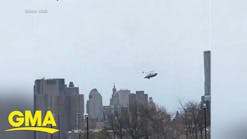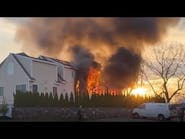From a deadly fire in a Brooklyn, NY, Waldbaum's supermarket to California's first gigafire that was so complex, it was given the name Complex, and the Mann Gulch wildfire in 1949 to 2023's Maui wildfire that destroyed the town of Lahaina, this month in fire history has a wide range of tragic events.
Aug. 2, 1978, Brooklyn, NY—Waldbaum's Supermarket Fire
On August 2, 1978, a devastating fire occurred at the Waldbaum's Supermarket in Sheepshead Bay, Brooklyn, NY, resulting in the deaths of six FDNY firefighters.
The fire broke out at 8:39 a.m. at the 15,000-square-foot supermarket. The store was undergoing renovations but remained open for business.
In his article for Firehouse magazine, Waldbaum’s: 40 Years Later, FDNY Deputy Chief Jay Jonas reported that “At 8:39 a.m., Brooklyn Box 3300 was transmitted by the Brooklyn fire dispatchers. It was a telephone alarm for a fire at Waldbaum’s Supermarket. Engines 254 and 321, Ladders 153 and 156, and Battalion 33 were dispatched to the fire. While responding, the Brooklyn fire dispatcher announced that they were ‘filling out the assignment’ due to numerous phone calls.”
Upon arrival, it was determined that the fire may have started on the second floor mezzanine. There was no visible fire, but there was a light smoke condition.
As the ceilings were being opened inside, the roof and outside vent firefighters went to the roof to perform vertical ventilation.
A “rain roof” had been installed that recreated the traditional bowstring curve of the roof so rainwater could drain away. Jonas reported that “Running the length of the building, the rain roof was constructed of wooden beams and a roof deck that was on top of the old roof deck. The original roof deck was 6 to 8 inches below the new rain roof.”
Inside, there were also two ceilings—a drop ceiling and an older tin ceiling above it. According to Jonas, the tin ceiling was not removed when the new ceiling was installed. The drop ceiling was 18 inches below the ornamental tin ceiling, which was attached to the bottom chord of the trusses and purlins. The original tin ceiling was 16 feet above the floor.
Crews reported that the roof seemed solid, but they were having difficulties cutting through the rain roof.
Conditions on the inside of the store seemed to be improving. Engine 254 was hitting fire in the ceiling of the mezzanine. The smoke condition was light to moderate. Members of Ladder 153 and Rescue 2 were pulling ceilings to gain better access to the fire.
It was a different story on the roof.
Jonas reported that “Scuttle covers were removed, and the scuttles showed heavy smoke. At first, there was very little smoke coming out of the cuts. The members operating on the roof did not know that there was a double roof installed, and it took some time for the members to identify the rain roof. The original roof would have had to be cut after the rain roof had been cut. This was not workable due to the depth of the original roof. So, members moved the cutting operations away from the center of the roof and those holes showed heavy smoke. The roof seemed solid. The roof conditions were indicative of a more severe fire condition than was being observed inside the store.”
At approximately 9:16 a.m., the members of Ladder 153 went outside to exchange their air cylinders. Battalion Chief Arthur Clark was up in the mezzanine supervising extinguishing efforts there by Engine 254 and Engine 321. Suddenly, out of the corner of his eye, Clark saw fire to his left and heard a “whooshing” sound. He ordered the companies to shut down the hoseline and back out. There was quite a bit of fire in the store now. A catastrophic event had occurred: Truss number five had collapsed, and a 4,000-square-foot area opened and erupted into intense fire.
The collapse plunged 12 firefighters into the flames below. While six were rescued, tragically, six others lost their lives. The firefighters who died in the line of duty were:
- Lt. James E. Cutillo, Battalion 33
- Firefighter Charles S. Bouton, Ladder Company 156
- Firefighter Harold F. Hastings, Battalion 42
- Firefighter James P. McManus, Ladder Company 153
- Firefighter William O'Connor, Ladder Company 156
- Firefighter George S. Rice, Ladder Company 153
Thirty-four firefighters, one EMT and one emergency services police officer were injured in the fire. Twenty-five firefighters ultimately required medical leave.
The fire was declared under control at 12:45 p.m., four hours after the first alarm.
August 5, 1949, Gates of the Mountain, MT—Mann Gulch Forest Fire
On August 4, 1949, a lightning storm swept across Gates of the Mountain, MT, igniting dry grasses and shrubs in Mann Gulch in the Helena National Forest. The fire was first officially reported around noon on Aug. 5 by a forest ranger who saw smoke rising from the gulch from a lookout approximately 30 miles away.
The combination of drought conditions, high temperatures, low humidity, and strong winds in the area created an environment highly susceptible to rapid fire spread.
The Forest Service dispatched 15 smokejumpers from Missoula to battle the blaze. The crew members landed about a half-mile away from the fire.
As they headed down the gulch, high winds caused the fire to suddenly expand, forcing them back uphill. The fire reportedly covered 3,000 acres in 10 minutes.
The crew supervisor, R. Wagner Dodge, stopped and created a safe area, but the others did not hear his calls to join him. Two of the smokejumpers, Walter Rumsey and Robert Sallee, found shelter in a crevice in the canyon’s rock wall. The other 13 firefighters were overtaken by the fire and lost their lives.
The firefighters who were killed by the fire were:
- Robert J. Bennett
- Eldon E. Diettert
- James O. Harrison
- William J. Hellman
- Philip R. McVey
- David R. Navon
- Leonard L. Piper
- Stanley J. Reba
- Marvin L. Sherman
- Joseph B. Sylvia
- Henry J. Thol Jr.
- Newton R. Thompson
- Silas R. Thompson
Firehouse.com shared a story commemorating the 70th anniversary of that tragic day.
Aug. 8, 2023, Maui, HI—Maui Wildfires
On Aug. 8, 2023, wind-driven wildfires on the island of Maui destroyed more than 2,200 structures and caused about $5.5 billion in damages. The most significantly impacted area was the historic district of Lahaina, where 102 lives were lost, making it one of the world’s deadliest wildfires on record.
The first reported blaze was a brush fire in the Olinda Road area of Kula, which eventually burned through about 700 acres. Another fire ignited near Lahaina Intermediate School.
These wildfires were fueled by a combination of dry conditions and strong winds. There were reports that the 80 mph winds may have knocked down power lines owned by Hawaiian Electric Industries, and they may have sparked the fires.
The high winds fueled brush fires that destroyed thousands of acres and caused extensive property damage. This led to widespread evacuation of residents from Lahaina, Upcountry Maui and several Kohala communities on Hawaii island.
Rescue efforts were hampered by the high winds, road closures, power outages and 9-1-1 system failures. Helicopter rescues were impossible in the 80 mph winds.
The fires hit close to home for Hawaiian firefighters as well, as many of them lost their homes as they tried to save others.
Firehouse.com was all over this story, from tracking the rising death tolls, to the response to the after-action report and U.S. Fire Administrator Lori Moore-Merrell’s visit with local and federal relief officials.
August 16, 2020, Northern California—The August Complex Fire
The August Complex was a massive wildfire that burned in the Coast Range of Northern California, in Glenn, Lake, Mendocino, Tehama, Trinity, and Shasta Counties. The complex originated as 38 separate fires started by lightning strikes on August 16–17, 2020. Four of the largest fires, the Doe, Tatham, Glade, and Hull fires, had burned together by August 30.
By Sept. 10, the August Complex fire had become the largest blaze in California history. It burned a total of 1,032,648 acres across six counties in Northern California, making it the first “gigafire” (more than one million acres) in California history.
The fire largely burned within the Mendocino National Forest, with portions spilling over to the Shasta-Trinity National Forest and Six Rivers National Forest in the north, as well as private land surrounding the forests. Large areas of the Yolla Bolly-Middle Eel Wilderness and Yuki Wilderness also burned. Rugged terrain combined with consistent high winds and record heat complicated firefighting efforts. Although more than 2,900 personnel were deployed to the fire through mid-September, it took almost three months to fully contain the fire.
After a couple of small rain events and favorable weather, firefighters and aircraft were able contain most of the fire by early November. The fire was finally extinguished on Nov. 12.
Due to the remote location of the fire, there were no civilian fatalities, while 935 structures were reported destroyed. However, one firefighter was killed, and at least two others were seriously injured. Diana Jones was a Firefighter/EMT with the Cresson Volunteer Fire Department in Texas who had spent the last few summers doing contract firefighting with her son.
Firehouse's Peter Matthews talked with Chief Chad Costa on a Firehouse.com podcast about the deadly and dangerous 2020 wildfire season.
Other Major Incidents This Month in Fire History
August 9, 1965, Searcy, AR—Titan II ICBM silo fire kills 53
August 10, 1955, Andover, OH—Gateway Restaurant fire kills 22
August 11, 1874—First Sprinkler head patented by H.S. Parmelee
August 17, 1975, Philadelphia, PA—Gulf Oil refinery fire causes $44 million in damages
August 24, 1812, Washington, DC—Washington set afire by British troops during War of 1812
August 25, 1974, Berkeley Springs, WV—Washington House Hotel fire kills 12
August 31, 1968, Gary, IN—In Crowd lounge fire kills 13








